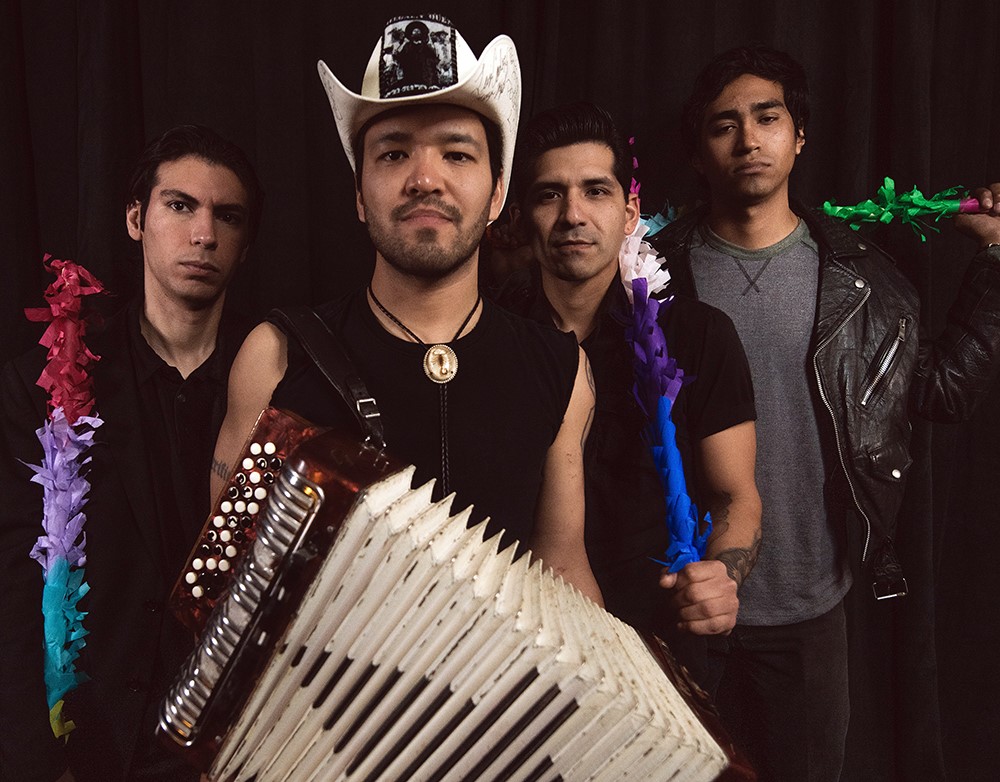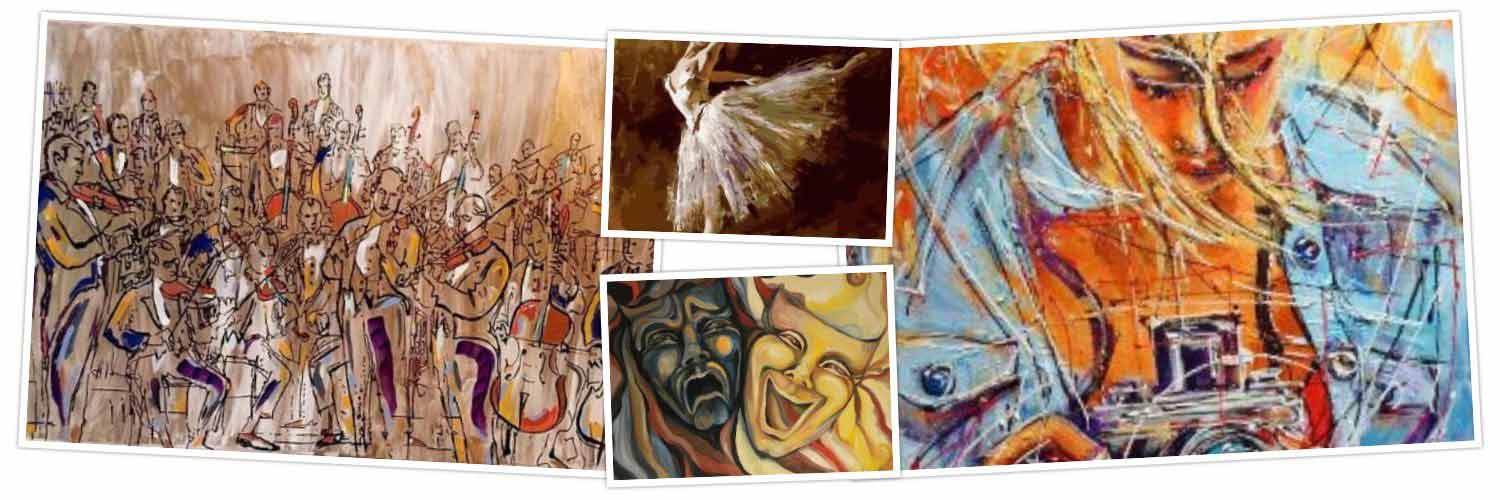Conjunto Gains Popularity, Embraces Innovation
BY SUZI CASTELLAW with JASMINA WELLINGHOFF
As the winds begin to blow with the promise of a cool shower, I am waiting to meet with Nicolas Valdez under the beautiful Jesse Trevino three-dimensional mosaic of a Mexican votive candle that adorns the Guadalupe Theater on South Brazos.
Valdez is a conjunto musician and playwright who recently premiered his play “Conjunto Blues” during the 2021 Tejano Conjunto Festival, organized by the Guadalupe Cultural Arts Center.

The one-man show explores the history and social conditions that led to the development of conjunto music as an artistic expression of the Chicano experience. The stage is set with familiar items found in homes and cantinas of poor, working class Mexican Americans. As the story unfolds, Valdez portrays multiple colorful characters from his childhood, memories are highlighted by carefully crafted anecdotes, photographs projected on the stage, and, of course, conjunto music.
Valdez describes his play as “biting.”
“I never wanted to create anything that was romanticized,” he explained. “I look at our community through a critical lens and I think it is important for us to acknowledge our own hang-ups, the things we can do to ourselves to perpetuate our situation. Ultimately, we are still fighting for a place at the table. We’ve been serving the table, and we’ve been wiping the table down, but they have yet to give us a place at the table. Conjunto music as a genre is such a great example of what we’ve been able to do as a community to put our foot in the door, to write our own stories and to reclaim our own history.”
Early conjunto artists were singing about issues in the community – issues about addiction and incarceration in a way that was allowed, he noted. “Normally, this culture is very shut down; you don’t really talk about those things. So, the music has always been a place where people can be a little more vulnerable. Latino men can talk about their feelings, using the music as an act of expression.”
Conjunto is about 100 years old. As Germans settled in the Hill Country in the early part of the 20th century, they brought with them their folk music, which was largely accordion-based. Fascinated by “the squeezer,” young Chicano musicians flocked to German-American venues to see how the polkas and waltzes were played, and eventually started acquiring their own accordions and incorporating them in their music. Thus, was born a novel genre that became the music of the Texas-Mexico borderlands. On the Mexican side of the border, a similar new hybrid music became known as Norteno.
Regardless of the variation in name, style, and territory, what each incarnation does share are the melding of the German polka waltz and the swagger of the Latin cumbia all propelled by the accordion, an instrument uniquely capable of expressing joy and melancholy almost simultaneously.
Early Conjunto bands were poor travelling troubadours, playing songs rich in local legend, love, and heartbreak as they followed the migrant camps from Texas, Arizona, California, and Chicago to provide music for bandos, quinceaneras and fiestas.
Juan Tejeda, former professor of Mexican American studies at Palo Alto University and founder of the Tejano Conjunto Festival here in San Antonio, explains that the Mexican culture itself is mestizo and that Conjunto is really an international mix of the Cuban bolero, the Columbian cumbia, African music, and German polka, which ultimately characterizes and symbolizes the Chicano experience.
At its core, conjunto is a quartet lead by the accordion and the “bajo sexto” a Mexican 12-string guitar, accompanied by the bass, either an old school tololoche (upright bass) or a modern electric bass, and a standard trap drum set. Any other variation becomes a progressive fusion of, or a sound derived from Conjunto.

Like many things in life, for the traditions of Conjunto to continue and prosper it must grow, evolve, and progress and this process relies heavily on being embraced by younger generations. Tejeda explains that continuing to break traditional boundaries is one of the ways of pulling in the younger crowds and perpetuating the culture. “There is a tradition to conjunto, but we have always had those people pushing the limits and experimenting with the genre” he said. He names several artists and bands from the 1960s and 70s, the heyday of conjunto, including Steve Jordan, Flaco Jimenez, David Lee Garza of Los Musicales. “Those musicians were already doing things like adding horn sections, using synthesizers, integrating rock riffs, blues, and country music.”
Several new artists on the horizon in San Antonio are Brenda Martinez, Juanito Castillo and the band Volcan. Brenda Martinez nicknamed La Reina de Polkas, has issued a very traditional debut album, “Favoritas de mis Padres,” under the Rancho Alegre label and was nominated by the Tejano Music Awards, Best New Female Artist. Accordion player and multi-instrumentalist Juanito Castillo played with Steve Jordan and acquired a lot of his influences. Volcan has integrated horns and different tropical and African rhythm sounds. “They are all exciting young groups,” said Tejeda, “significant in getting the youth more involved.”

Valdez also describes several ways that Conjunto has changed in recent years. “You have branches of Norteno and Banda that are now like gangster rap, very glorified violence. They come on stage with gilded automatic rifles and stuff. It’s pop, you know.”
Another contemporary derivative is the music of San Antonio’s Pinata Protest, whose style is often referred to as Conjunto Punk. The group often recasts traditional songs like “Volver, Volver” and “La Cucaracha” into a more contemporary format.
“The idea of the band grew out of a newly found love for the music that I grew up with, on my radio, at family events, virtually every public place my parents took me to,” explained Alvaro Del Norte, founder of Pinata Protest. Returning to San Antonio from college, he rediscovered his love of Tejano, cumbia, mariachi and conjunto and had a real itch to start his own band. In the beginning, he melded the two genres, punk and conjunto, for the sake of curiosity, as he was playing at local dive bars on weekends. Nowadays, grateful for the journey the band has taken him on through the years, he looks at his music-making from a special perspective. “I like to think that I am doing this for all those bi-cultural Mexican American kids who grew up like me,” he said. “I remember being a teenager and listening to bands like Los Crudos, Union-13, and Voodoo Glow Skulls and being able to identify with them in a genre that was vastly ethnocentrically British American.” It is Del Norte’s hope to come full circle extending that same experience to future generations.
Ignacio “Nachito” Morales from Dallas, Texas, learned of conjunto in much the same ways as Del Norte, but his band chose a more traditional sound. He and his brothers, Rudy the bass player and Cheque the drummer, known as Los Morales Boyz, admired many of the traditional artists of Conjunto and Tejano, like Hometown Boys, Flaco Jimenez and Emilio Navaira. They began playing for audiences at a noticeably young age and caught the eye of many of the pioneer bands they admired, often being invited to play with them.
Now with a decade of experience under their belts, Morales describes how the band continues to promote the genre. “We have a broad selection of music when we play. We try to incorporate all the different styles. Every area of Texas has their own unique style–San Antonio, Houston, The Rio Grande Valley–and we try to incorporate them in our sets.” Los Morales continues to reach out to new audiences. They were recently invited to collaborate with the Norteno band Grupo Zenzio for a live performance on YouTube.
While the genre has been dominated by men, there are finally more women joining the fun. In fact, the upcoming event, The Conjunto Heritage Taller tardeada, will feature a number of women – Crystal N’ Crew, Veronique Medrano, Susan Torres, Christina Valdez, and the above- mentioned Brenda Martinez.
Musician, author, and historian of Conjunto music, Dan Margolies describes Conjunto as a living tradition and sustainable culture. He attributes it to an intentional effort by the culture to adjust to changes in taste and shifts in social needs.
“It kind of naturally evolves with the pace of Tejanos,” he said. Although one should never take anything for granted, Margolies is extremely optimistic that Conjunto is not in danger of losing popularity. “In some ways it is stronger than it has ever been because of a large number of young people playing and listening to it. People stepped up and started programs teaching it to kids and creating venues and festivals where it can be played. Forty years ago, there wasn’t a Tejano Conjunto Festival. Now it is a huge annual event. Much of the vernacular music around the country has just vanished whereas Conjunto has flourished. Conjunto has really been a model of the way that a sustainable culture gets built.”
Margolies, who is a consultant for the Tejano Conjunto Festival, reports that even though the festival was online due to COVID-19, it still reached a global audience and was well received. Although it is almost impossible to track how many people it reached, “We definitely had a good audience,” he noted.
Tejada is proud that his brainchild, the Tejano Conjunto Festival, has played a significant role in the preservation and promotion of the genre.
“We have taken the music out of the barrios and cantinas and placed it on the world stage…opening it up to new audiences,” he remarked. “And we are teaching it to new generations.”
Beginning in the 1980s, the Guadalupe in San Antonio and later the Martinez Cultural Arts Center in the Valley started providing the first classes for Conjunto accordion and bajo sexto in the country. Today, there are a number of schools in Texas with Conjunto programs that are developing young artists, including South Side High School in San Antonio. The educational programs are playing a significant role in the preservation of the genre and passing on the traditional teaching to younger people. “I think we have more young people performing the music than we have had in our history because of these programs,” said Tejeda.
Both Nicolas Valdez and Nachito Morales began playing accordion as young boys. Valdez was encouraged by his grandfather to take accordion lessons, and at the age of 9, he began studying traditional conjunto with master accordionist Valerio Longoria Sr. at the Guadalupe Center.
Morales remembers being fascinated by his father’s accordion and was caught playing with it several times as a young boy. Rather than scold his 10-year-old son, Morales’ father challenged him to learn 10 songs. If he could do that, he would buy him an accordion of his own. “Two weeks later I was like, Dad, I know all the songs,” Morales recalled, laughing. “So, I guess it started from there.”
Valdez eloquently sums up our meeting under the shade of the Guadalupe Cultural Arts Center, “Conjunto is a uniquely American border experience. The influence of the German settlers, the Mexican ballad traditions, the Spanish guitar that became the bajo sexto, all those things had to come together in a way that could only uniquely happen here.”
Upcoming Events:
The Conjunto Heritage Taller tardeada
August 7, 6 p.m.
Dakota East Side Ice House, 433 S. Hackberry St.
Free admission
Vegas Music Week 2021
August 19-21
Westgate Las Vegas Resort & Casino, 3000 Paradise Road, Las Vegas, NV 89109,702-732-5111
Pinata Protest
September 3, 2021 – 8PM,
Palomino Fest & Pro Rodeo; 2401 Garner Field Rd., Uvalde, TX 78801
